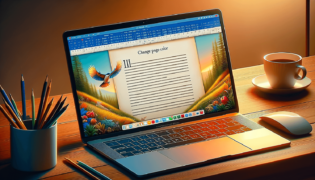
How to Insert a Cover Page in Word
To insert a cover page in Word, simply open your document, go to the ‘Insert’ tab, choose ‘Cover Page’ from the drop-down menu, and select one of the available templates. You can then customize the text and images on the cover page to fit your document. This feature allows for a professional and polished look for reports, assignments, and other documents. Remember, the cover page is the first impression, so select a design that aligns with your document’s content and tone.
Quick summary
- To add a cover page, navigate to the ‘Insert’ tab in Word.
- Select ‘Cover Page’ from the menu and pick a design.
- Customize the template with your text and images.
- Choose a design that matches your document’s tone.
At LearnWord.io, we understand the importance of presenting your documents in the best possible way. That’s why we’re diving deeper into how to insert a cover page in Word, ensuring that you have all the information you need to create documents that stand out. Whether it’s for a school assignment, a business report, or any other document, the right cover page can make a significant difference.
Choosing the Right Template
Word offers a variety of cover page templates, from simple and elegant designs to more complex and colorful options. Consider the purpose of your document and your audience when selecting a template. A professional report might require a more conservative design, while a creative project could allow for more artistic freedom. Word’s library of templates is designed to cater to a wide range of needs and preferences.
Customizing Your Cover Page
Once you’ve selected a template, clicking on it automatically inserts it into your document. You can then edit the text fields by clicking on them and typing your content, such as the title of your document, the author’s name, and any other relevant information. Additionally, you can replace the default images with your own by right-clicking on the image and selecting ‘Change Picture.’ This customization allows you to align the cover page closely with the theme and purpose of your document.
Adjusting the Layout
After inserting and customizing the cover page, you might need to adjust the layout. This can include changing the font size or style to match the rest of your document, modifying the color scheme, or repositioning elements for better visual appeal. To move text boxes or images, simply click and drag them to the desired location. For more precise control over the layout, you can use the ‘Format’ tab to access additional options like alignment, spacing, and more.
Final Touches
Before finalizing your document, preview the cover page to ensure that all elements are correctly placed and that there are no typos or formatting issues. It might be helpful to ask someone else to review it, as a fresh set of eyes can often catch errors you might have missed. Once you’re satisfied with the cover page, save your document. Your document is now ready for submission or presentation, featuring a professional and engaging cover page that sets the tone for the rest of the content.
At LearnWord.io, we believe that a well-crafted cover page can elevate your document and leave a lasting impression on your readers. By following these simple steps to insert a cover page in Word, you can enhance the presentation of your work and ensure it gets the attention it deserves. Whether you’re working on an academic paper or a business report, taking the time to select and customize a cover page is a worthwhile effort that reflects your commitment to quality and professionalism.
Featured Posts
- No pillar pages found.








